|
'SHAKER'
Top Mount Intercoolers

|
Sorry - There
is no PERFECT Intercooler -
they all have
their drawbacks
!
The trick is to pick the best for your application and pocket !
ARE Shaker
Top Mounts cannot match front mounts for outright cooling - in
most cases - in a direct comparison. They can not be physically
as big & unless the vehicle has bull bar, mesh, driving lights,
winch etc., do not get the same volume of ambient air per core
fin area. If the vehicle is equipped as above, then cooling
efficiency will be very similar & in some cases top mounts can
be better.
ARE
Shaker Top Mounts do not place any extra stress on
the engine cooling system (radiator) like a front mount or even
the radiator of an air/water system. This is very important for
vehicles like the Toyota Troopie & Tray Backs that struggle in
summer with a Turbo fitted. No point in having a powerful engine
that has to be driven at half throttle or it overheats !
ARE Shaker Top Mounts do
definitely provide less 'turbo' lag, they are more responsive to
throttle control. The longer the piping & sharper bends of a
front mount, the more noticeable lag is.
ARE Shaker Top Mounts
are less prone to front end damage & in certain circumstances,
blocking with mud, insects & grass seed. They are usually easier
to remove to clean.
ARE Shaker Top Mounts
provide better cooling above 50 kph over air/water intercooling.
Note - this is a generalization & each vehicle has to be
treated on it's own merits. Up to 35 kph, air water is
always superior, 40 to 50kph, they are line ball, above 60 kph
top mounts are better & this increases with speed. I have to say
that up too 25kph, air/water intercooling is far, far superior.
ARE Shaker Top Mounts
are near half the price of our air/water kits & appear to be
cheaper in price to others quality front mounts.
ARE Shaker Top
Mounts when fitted with one of our modified plennums (exchange),
are in a performance league of their own when the boost is
raised 5 & more psi over oe factory specifications. Most factory
plennums - well, they should really be called intake manifolds,
as most are just an agricultural log of the smallest internal
volume with bosses molded internally into some runners too give
plenty of meat for studs & bolts. Having said this, it is heaps
more detrimental to oversize a diesel intake ( & intercooling
piping) than for a petrol engine - far more critical.
|
Apology
Our fiberglass Shaker Scoops will be available very soon, the
first one will cost near $2000 & we have to get some money back
in the bank after the
expense of our development programme. They will come in two
sizes. All this testing time & making components too test burns
up the $$$$ at a great rate.
 |
 |
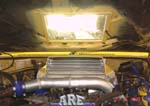 |
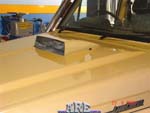 |
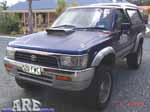 |
This is when we were getting
serious with top mounts. Terry
was off around Australia &
liked the idea of more power,
but also wanted better economy & also realized
the much more stable temps increase engine life
by a small margin. |
Terry had the time (just retired)
so he did the scoop himself. This was the best
after market available then.
His gains, especially towing, made him a happy
man. Sealing the scoop too the intercooler
reliably is what got me thinking about our
'shaker' system. It seals 100% for life, giving
the best consistent performance possible. |
Peter uses his 'troopy' to tow 2 tons of mowing
gear & 2.5 tons of fishing gear. As he mostly
drives the same roads, He knows the power &
economy gains our ic. gave him.
The louvers are extremely important to even the
air flow across & through the face of the core
for maximum cooling. Otherwise, most of the air
flows through down the back of the core, little
through the front, leaving the charge air hotter
! |
The 'shaker scoop' offers the
'look' for those of us old enough
to remember the
Ford Falcon Phase 3,
but, most importantly, forces
every bit of available air through
the intercooler - at low speed too! For a highly
modified engine, they can't dissipate as much
heat as a large front mount or air-water ic. |
My trusty old test stead. Owned
it for 8 years & this is the 5th different
intercooler we've made for it
Hand made alloy scoop is one of a few tested. we
now know what works the best & will be making
two sizes available in fiberglass, from the same
F1 race boat builder. |

The Theory
behind Our 'SHAKER' Ic's
|
I
don't know how I can stress enough how unique
& accurate our in house computer program is for
sizing intercoolers, we have been developing
and refining this program over ten years now. It
gives us an extremely detailed knowledge of
intercooling. |
From the 11 years of R&D & real world testing,
our computer programme tells us very closely how an intercooler
should work, which shortens our development time. Unfortunately,
there as some aspects that it can't tell us, the main one being
the ambient air flow through the ic. All models of vehicles vary
& then people add on their own accessories, some of which can
have a substantial bearing on the final result. In this case, we
have to take an educated guess until we get known data.
|
M |
A |
B |
C |
D |
E |
F |
G |
H |
I |
J |
K |
N |
| ARE |
Toy 3.0L |
3800 rpm |
12 psi |
366 cfm |
25°c |
100°c |
80°c |
4.1
kw |
233 btu |
52.2 kph |
0.024
sec |
no scoop |
| |
Toy 3.0L |
4100 rpm |
12 psi |
385 cfm |
25°c |
110°c |
36°c |
16.8 kw |
957 btu |
56.3 kph |
0.022 sec |
With
scoop |
| |
|
|
|
|
|
|
|
|
|
|
|
|
| |
|
|
|
|
|
|
|
|
|
|
|
|
| |
|
|
|
|
|
|
|
|
|
|
|
|
Code & Details for above chart.
|
A |
engine capacity |
B |
Engine revs computer modeling
worked at, I believe maximum sustainable ! |
|
C |
Maximum boost pressure out of turbo used |
D |
cfm - cubic feet per minute of
charge air forced into engine |
|
E |
ambient temperature - outside air temp for
this calculation - only small effect. |
E |
Temperature of charge air out of
turbo. Least known of any data, but important |
|
G |
Temp. of air out of intercooler - more
effecient - more power - more economy |
H |
Amount of heat intercooler pulls
out of charge air measured in kilowatt/minute |
|
I |
Amount of heat ic. pulls out of charge air
measured in British Thermal Units |
J |
Speed of the charge air
traveling through the intercooler core |
|
K |
Time it takes a molecule of air to travel
through the core - bloody quick ! |
M |
Intercooler manufacturer |
|
N |
Any notes |
|
|
 |
|
|
|
|
| This is the same flow bench I
have used for 15 years. It's had quite a few
switches & worn out a few motors, but Woody
-Fataz Engines-keeps it in tip top shape. |
|
|
|
|
|
|
|
|
|
|
| |
|
|
|
|

The 'Actual'
in Our 'SHAKER' Ic's
If you want
High Performance for more power & lower economy - here it
is.
 |
 |
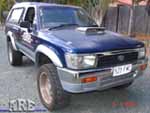
|
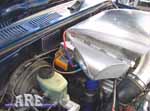 |
 |
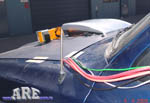 |
| It's nearly there.
Intercooler on, waiting for the scoop & louvers.
Surprisingly, this achieved 43.9% efficiency ! |
I hand formed this
scoop out of 2mm alloy sheet. Notice how it rolls
outwards for a bigger opening at the top. The higher
off the bonnet, the more air & more cooling. |
Production fiberglass
scoops will be available very soon. They will come
in two widths. |
We had to make a
mount system for our sensor too fit in close under
the core for an accurate reading. It's not allot of
air, so we can't afford any spillage & the converted
sensor is not cheap, so no damage |
This is to see how
much air is actually flowing over the bonnet & at
the scoop mouth. A bloody lot! |
This is as much too
show the rear & side profile of the scoop as much as
our logger cables & sensor position. |
|
*A |
If you check the graphs
in the air/water page, a 100 series
Landcruiser not intercooled, had an
efficiency of 1.7% in the cast cross over
pipe. Our ic. just with a hole in the bonnet
has an efficiency of 44%. Only one patch of
red where the intercooler turned into an
'interheater'. A very small pressure
drop, measured in tenths of one psi. This
intercooler is actually a little over size
for current boost. |
|
*B |
Note the air speed
through the core, it pretty much mirrors the
car road speed. Also how after the initial
heat soak form setting the logger & moving
off, the ic out temp. is on a downhill curve
until I stopped the car, turned around &
gassed it back up the hill. I just noticed
it does 0 to 90kph up a steep hill in 13
secs. |
|
*C |
This is why I struggle
being polite about Australian companies
that are using Chinese Intercoolers
(have a look at their pictures closely or
ask them - & I have to say Ebay is the
easiest place too spot them) in their 'kit'
! We have spent endless hours testing to
achieve the optimum fin pitch ratio & pay
extra money to the (Australian) factory to
make our cores too our specs. It's a fine
line between having an open fin pitch &
letting plenty of ambient air through but
not having enough fin contact for good heat
dissipation, too a close fin pitch which
will dissipate allot of heat, but not let
the air through & becomes a heat soak !
|
| |
|
|
|
|
 |
| |
|
|
|
|
Our
logger was in Sydney receiving another
speed probe, this dual digital
thermometer is accurate but can't store
data. |

|